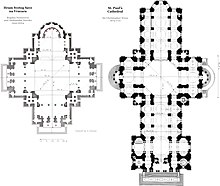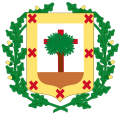Latin cross
Latin cross (also Passion Cross or Long Cross ) is the name for a cross in which the longitudinal bar is longer than the transverse bar and this crosses the longitudinal bar above its center. In the western churches it is the most common form of the Christian cross .
The cross symbolically refers to the union of heaven and earth: the longitudinal bar stands for the divine, while the transverse bar symbolizes a bond with the earth.
history
The representation of a Latin cross can be traced back to the 4th century, a representation of the cross without the crucified can be found for the first time on sarcophagi of the 4th / 5th century. Century.
The Latin cross prevailed above all in Western Christianity, where it was perceived as the actual form of the cross of Jesus (hence the "Passion Cross"). It is therefore the common shape of the crucifix in the Western tradition, with a few exceptions.
architecture
The floor plans of the Romanesque and Gothic churches are mostly in the shape of a Latin cross. The transept crosses the nave near the altar; the resulting crossing separates the choir and thus the chancel from the lay people.
heraldry
In heraldry , the cross can appear in two forms; once as a common figure in the field of a coat of arms without touching the edge of the shield and as a herald image with touching the edge of the shield to split the coat of arms.
The basic shape of the Scandinavian flags is a Latin cross rotated by ninety degrees (" Scandinavian cross "); this goes back to the Danebrog , whose current form can be traced back to 1219.
Characters
In Unicode , the Latin cross is included as U + 271D latin cross and as an emoji ✝️.
Individual evidence
- ↑ a b Gerd Heinz-Mohr: Lexicon of symbols. Images and symbols of Christian art (= Diederich's yellow row. 150 Christianity ). Diederichs, Munich 1998, ISBN 3-424-01420-6 , p. 177.
- ↑ in the late Gothic where Christ is represented on a Y-shaped tree of life . For example on the portal of the Minorite Church in Vienna .
- ↑ ✝️ Latin Cross Emoji. In: Emojipedia . Retrieved October 11, 2017 .












